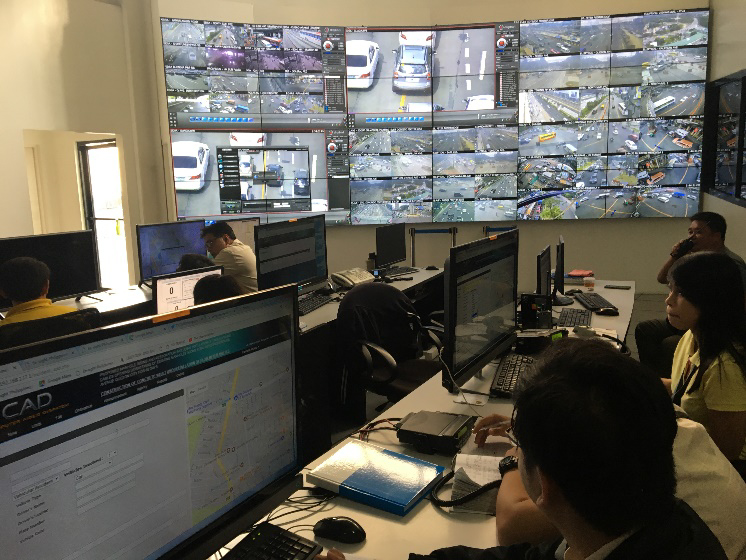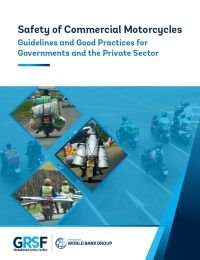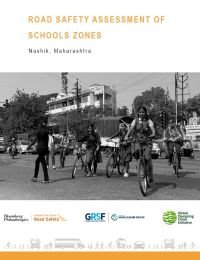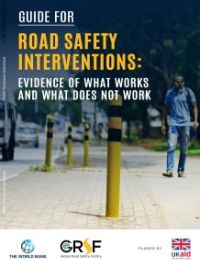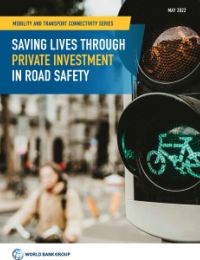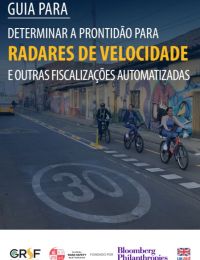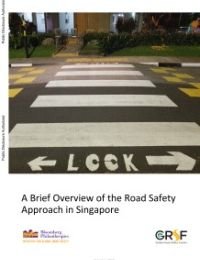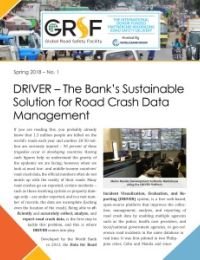Publications
1-9 of 9
-
-
-
Speed Management
Guide for Determining Readiness for Speed Cameras and Other Automated Enforcement
July 2022
-
To briefly identify the powerful practical value of AE in saving lives and reducing injuries.
-
To identify issues and criteria to be considered before commencing automated enforcement. To identify steps to be taken to achieve readiness for automated enforcement. To identify issues to improve existing automated enforcement systems.
-
To provide a checklist to ensure adequate consideration is given to issues to assess readiness to implement an AE system or improve an existing system.
- Identificar brevemente o poderoso valor prático da AE em salvar vidas e reduzir ferimentos.
- Identificar problemas e critérios a serem considerados antes de iniciar a fiscalização automatizada. Identificar etapas a serem tomadas para atingir a prontidão para a fiscalização automatizada. Identificar problemas para melhorar os sistemas de fiscalização automatizados existentes.
- Fornecer uma lista de verificação para garantir que a consideração adequada seja dada aos problemas para avaliar a prontidão para implementar um sistema AE ou melhorar um sistema existente.
-
-
Road Safety Data
DRIVER: The World Bank’s Sustainable Solution for Road Crash Data Management
March 2018
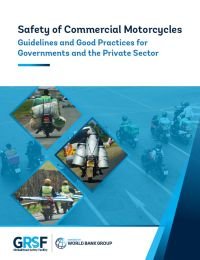
The global surge in commercial motorcycles is transforming mobility and livelihoods in developing countries, but is also fueling a growing crisis of road crashes and fatalities. This report provides practical, evidence-based strategies to address the safety challenges facing this vital sector.
The report highlights that improving helmet quality, enforcing safety standards, expanding insurance, and leveraging technology are critical for reducing risks. It calls for coordinated action among governments, companies, and insurers to ensure safer roads for riders and communities.
Implementing these recommendations can help countries harness the benefits of commercial motorcycles while safeguarding lives and supporting economic growth.
Note: This is the web-optimized version of the report. Download a printable version here.
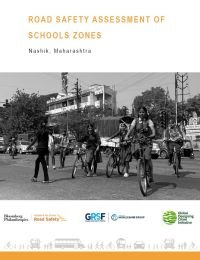
This report spotlights dangerous conditions around school zones in Nashik, Maharashtra, and offers a practical roadmap to protect children during their daily commutes. Developed in partnership with the Nashik Municipal Corporation under the Bloomberg Initiative for Global Road Safety (BIGRS), the report focuses on two schools—Adarsh English Medium School and NMC School 57—where students face serious risks due to poor road infrastructure.
Surveys revealed that while 86% of students at NMC School 57 walk to school, many cite unsafe roads, speeding vehicles, and a lack of footpaths, crossings, and lighting as major concerns. The report recommends a range of interventions: better pedestrian and cycling infrastructure, traffic calming measures, improved signage, and reduced speed limits near schools.
It also calls for establishing School Zone Road Safety Committees to coordinate action and promote awareness. By prioritizing the safety of young pedestrians, this report provides a replicable model for safer school zones in fast-growing cities across India.

Acidentes de trânsito resultam em cerca de 1,35 milhão de mortes e 50 milhões de feridos no mundo todo por ano, com mais de 90% deles ocorrendo em países de renda média e baixa (LMICs). Além da dor e do sofrimento óbvios que isso inflige a indivíduos e comunidades, essas mortes e ferimentos também representam um grande fardo financeiro, especialmente para os LMICs, ao desacelerar o crescimento econômico.
A escala da resposta atual a essa crise contínua não corresponde ao tamanho do problema. Além disso, recursos limitados de segurança no trânsito são frequentemente gastos em intervenções ineficazes ou abaixo do ideal. Embora o conhecimento sobre segurança no trânsito tenha melhorado nas últimas décadas, ainda há necessidade de melhorar a tomada de decisões ao selecionar e aplicar intervenções eficazes de segurança no trânsito baseadas em evidências. Intervenções eficazes são aquelas que reduzem ferimentos fatais e graves.
O Global Road Safety Facility (GRSF) do Banco Mundial desenvolveu este guia baseado em evidências sobre "O que funciona e o que não funciona" na segurança no trânsito em resposta à necessidade crítica de soluções eficazes baseadas em evidências.
Este guia foi preparado para ajudar os leitores a entender que nem todas as intervenções de segurança no trânsito são igualmente eficazes e que o que parecem ser abordagens de "senso comum" para selecionar intervenções de segurança no trânsito muitas vezes não serão as melhores. Embora algumas forneçam benefícios, outras têm impactos muito limitados ou mesmo negativos, apesar de serem comumente — e erroneamente — recomendadas ou aceitas. O guia oferece uma série de recomendações com foco em intervenções em países de baixa e média renda, embora as informações também possam ser relevantes para todos os países. O conteúdo será valioso para aqueles que trabalham com segurança no trânsito em níveis de política ou profissional, incluindo líderes de equipe técnica do Banco Mundial e outros que buscam estabelecer, expandir ou melhorar programas de segurança no trânsito em países de baixa e média renda.
O guia define o conhecimento sobre intervenções baseadas em evidências dentro de um contexto de "Sistema Seguro", fornecendo conselhos sobre cada um dos pilares do Sistema Seguro (gestão de segurança no trânsito, estradas seguras, velocidades seguras, veículos seguros, usuários seguros das estradas e cuidados pós-acidente), ao mesmo tempo em que reconhece que soluções baseadas em evidências devem ser extraídas de todos os pilares para produzir resultados eficazes de segurança no trânsito. No centro deste documento está uma tabela de resumo com uma visão geral de intervenções benéficas e não benéficas com base em evidências científicas sólidas. Isso é seguido por informações mais detalhadas, incluindo estudos de caso e referências à base de evidências para dar suporte ao resumo.
Muitas intervenções rodoviárias seguras são recomendadas para adoção, incluindo transporte público integrado, sistemas de barreiras centrais e de beira de estrada, medianas, infraestrutura para dar suporte à velocidade operacional apropriada para usuários da estrada, rotatórias, separação de nível e intervenções para reduzir a exposição ao risco em cruzamentos, caminhos e travessias de pedestres, instalações separadas para bicicletas e motocicletas e sinais de trânsito e marcação de linhas (incluindo marcação de linhas áudio-táteis). Algumas delas são altamente eficazes, com uma redução de até 70 ou 80 por cento em fatalidades e ferimentos graves (por exemplo, barreiras de segurança e rotatórias).
Várias intervenções relacionadas à velocidade também produzem benefícios significativos, com algumas capazes de quase eliminar mortes e ferimentos graves. Exemplos de intervenções eficazes de velocidade incluem acalmia de tráfego (incluindo lombadas e chicanes), rotatórias, cruzamentos e cruzamentos elevados, tratamentos de entrada, limites de velocidade mais baixos (incluindo zonas de 30 km/h (20 mph) para pedestres) e radares de velocidade.
Uma variedade de intervenções baseadas em usuários de estradas foram implementadas ao longo de muitos anos, com exemplos eficazes incluindo ampla prática supervisionada na estrada e/ou sistemas de licenciamento graduados como parte do sistema de licenciamento de motoristas, aumento da idade para elegibilidade da carteira de motorista, treinamento e teste de percepção de risco, educação pública e campanhas como parte de uma estratégia integrada (especialmente comunicando a fiscalização para aumentar a dissuasão geral), fiscalização, penalidades, bloqueios de álcool, monitoramento de fadiga e velocidade e aumento das taxas de uso de capacetes.
As principais intervenções baseadas em veículos incluem a aplicação de padrões mínimos de segurança de veículos e classificações de veículos (por meio do Global New Car Assessment Program, ou “NCAP”), cintos de segurança, manutenção periódica de veículos, luzes diurnas, protetores contra atropelamento em caminhões, Controle Eletrônico de Estabilidade e outras tecnologias avançadas de veículos.
O atendimento pós-acidente aprimorado também pode produzir melhores resultados de segurança nas estradas, incluindo sistemas para melhorar o tempo de resposta a emergências, melhor atendimento de emergência, melhores habilidades de primeiros socorros para o público e melhor atendimento hospitalar.
Igualmente importante, o relatório também identifica exemplos claros em que as intervenções não são eficazes. As piores são as intervenções que aumentam o risco. Isso inclui aumentar a velocidade de viagem sem melhorar a qualidade da infraestrutura de segurança, a maioria das formas de educação e treinamento de motoristas e passageiros pós-licença e muitas (mas não todas) formas de educação regular de motoristas em escolas (como aquelas que buscam aumentar as habilidades de manuseio de carros). O aumento do risco ocorre normalmente porque tais iniciativas aumentam o nível de confiança, levando a um aumento na tomada de riscos. Outras intervenções que não têm benefícios de segurança demonstrados devem ser evitadas. Isso inclui esquemas de licença por meio de solicitação ou pagamento, programas de treinamento ou educação dentro das escolas que visam melhorar o conhecimento sobre segurança no trânsito (incluindo visitas ad hoc de especialistas ou entusiastas em segurança no trânsito) e campanhas educacionais conduzidas isoladamente.
Existem intervenções alternativas eficazes para cada uma delas, conforme descrito neste documento, e elas devem ser aplicadas em vez disso. É extremamente importante que os recursos não sejam desperdiçados em intervenções ineficazes em nome da segurança no trânsito, mas sim que intervenções de segurança no trânsito baseadas em evidências sejam empregadas.
Há uma variedade de documentos disponíveis sobre a questão da eficácia das intervenções de segurança no trânsito, muitos dos quais são referenciados aqui. No entanto, há alguns pontos-chave de diferenças e valor agregado neste guia, incluindo uma síntese das evidências sobre uma ampla gama de intervenções e um contraste entre intervenções eficazes e não eficazes, permitindo que os leitores comparem as opções. Onde intervenções não efetivas são identificadas, intervenções efetivas viáveis são fornecidas, apoiando assim a tomada de decisões. O guia também fornece aconselhamento direto para aqueles que trabalham em países de baixa e média renda, com base em fontes-chave de informação, onde isso está disponível. É importante ressaltar que evidências concisas, porém robustas, são fornecidas em cada um dos pilares do Sistema Seguro.
Há uma necessidade de continuar construindo a base de conhecimento sobre intervenções efetivas de segurança no trânsito, particularmente em países de baixa e média renda, onde há uma série de lacunas no conhecimento. O conteúdo deste guia representa um resumo útil e atualizado do conhecimento atual para aplicação.

Road traffic crashes result in an estimated 1.35 million deaths and 50 million injuries worldwide per year with over 90 percent of these occurring in Low-Middle Income Countries (LMICs). Aside from the obvious pain and suffering this inflicts on individuals and communities, these deaths and injuries also place a large financial burden particularly on LMICs, by slowing economic growth.
The scale of the current response to this continuing crisis does not match the size of the problem. In addition, limited road safety resources are often expended on ineffective or suboptimal interventions. While road safety knowledge has improved over recent decades, there is still a need to improve decision making when selecting and applying effective evidence-based road safety interventions. Effective interventions are those that reduce fatal and serious injuries.
The World Bank's Global Road Safety Facility (GRSF) has developed this evidence-based guide on “What Works and What Does Not Work” in road safety in response to the critical need for effective evidence-based solutions.
This guide has been prepared to help readers understand that not all road safety interventions are equally effective and that what appear to be “common-sense” approaches to selecting road safety interventions will often not be the best. Although some provide benefits, others have very limited or even negative impacts, despite being commonly—and mistakenly—recommended or accepted. The guide offers a range of recommendations with a focus on interventions in LMICs, although the information may also be of relevance to all countries. The contents will be valuable to those working on road safety at policy or practitioner levels, including World Bank technical team leaders and others who seek to establish, expand, or improve road safety programs in LMICs.
The guide sets knowledge on evidence-based interventions within a “Safe System” context, providing advice on each of the Safe System pillars (road safety management, safe roads, safe speeds, safe vehicles, safe road users, and post-crash care) while recognizing that evidence-based solutions must be drawn from across pillars to produce effective road safety outcomes. At the core of this document is a summary table with an overview of beneficial and non-beneficial interventions based on sound scientific evidence. This is followed by more detailed information including case studies and references to the evidence base to support the summary.
Many safe road interventions are recommended for adoption, including integrated public transport, roadside and central barrier systems, medians, infrastructure to support appropriate operational speed for road users, roundabouts, grade separation and interventions to reduce exposure to risk at intersections, pedestrian footpaths and crossings, separated bicycle and motorcycle facilities, and traffic signs and line marking (including audio-tactile line marking). Some of these are highly effective, with up to a 70 or 80 percent reduction in fatalities and severe injuries (for example, safety barriers and roundabouts).
Various speed-related interventions also produce significant benefits, with some able to almost eliminate death and serious injury. Examples of effective speed interventions include traffic calming (including humps and chicanes), roundabouts, raised intersections and crossings, gateway treatments, lower speed limits (including 30 km/h (20 mph) zones for pedestrians) and speed cameras.
A variety of road user-based interventions have been implemented over many years, with effective examples including extensive supervised on-road practice and/or graduated licensing systems as part of the driver-licensing system, increased age for driving license eligibility, hazard perception training and testing, public education and campaigns as part of an integrated strategy (especially communicating enforcement to increase general deterrence), enforcement, penalties, alcohol interlocks, fatigue and speed monitoring, and increased helmet wearing rates.
Key vehicle-based interventions include applying minimum vehicle safety standards and vehicle ratings (through the Global New Car Assessment Program, or “NCAP”), seat belts, periodic vehicle maintenance, daytime running lights, under-run guards on trucks, Electronic Stability Control, and other advanced vehicle technologies.
Enhanced post-crash care can also produce better road safety outcomes, including systems to improve emergency response time, better emergency care, improved first aid skills for the public, and improved hospital care.
Equally important, the report also identifies clear examples where interventions are not effective. The worst of these are interventions that increase risk. These include increasing travel speed without improving quality of safety infrastructure, most forms of post-license driver and rider education and training, and many (but not all) forms of regular school-based driver education (such as those that seek to increase car-handling skills). The increase in risk is typically because such initiatives increase the level of confidence leading to an increase in risk taking. Other interventions that have no demonstrated safety benefits are to be avoided. These include license schemes through application or payment, training programs or education within schools that aim to improve road safety knowledge (including ad hoc visits by road safety experts or enthusiasts), and education campaigns conducted in isolation.
There are effective alternative interventions for each of these as described within this document, and these should be applied instead. It is extremely important that resources are not wasted on ineffective interventions on behalf of road safety but rather that evidence-based road safety interventions are employed.
There are a variety of documents available on the issue of road safety intervention effectiveness, many of which are referenced here. However, there are some key points of differences and added value in this guide, including a synthesis of the evidence on a broad range of interventions and a contrast between effective and noneffective interventions, allowing readers to compare options. Where noneffective interventions are identified, viable effective interventions are provided thereby supporting decision making. The guide also provides direct advice to those working in LMICs, drawing on key sources of information where this is available. Importantly, concise yet robust evidence is provided across each of the Safe System pillars.
There is a need to continue building the knowledge base on effective road safety interventions, particularly in LMICs where there are a number of gaps in knowledge. The contents of this guide represent a useful, up-to-date summary of current knowledge for application.
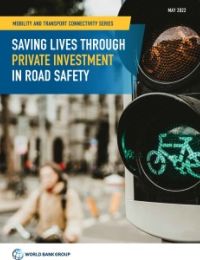
The World Bank estimates a significant funding gap in road safety of 260 billion to achieve SDG 3.6 and 11.2 in the next ten years, and recognizes that this gap cannot be closed through public funding alone and thus mobilization of private capital is required. The impacts of road traffic crashes reach far into the economy and can cost L/MICs as much as 6% of their GDP. The costs of a road traffic crash do not end at the roadside; they create ripple effects throughout the wider economy. Loss of income, property damage, insurance premiums, loss of taxes, and burdens on the health sector are just some of the far-reaching costs associated with road traffic crashes. Road traffic crashes can cost countries as much as 6 percent of their GDP and trap families in poverty as they lose income generating potential and focus on providing lifetime care.
This report examines the potential for private capital mobilization to close this gap. The report investigates the market failure to appropriately account for the cost of road crashes, which prevents private capital from flowing to road safety investments. The growth of socially responsible investing and the sustainable finance market offers a new opportunity to address this market failure. The report proposes different business models and financing instruments to channel private investment into road safety projects. These investment structures consist of subnational, public-private partnerships (PPPs) and corporate investments that can leverage the growing sustainable finance market, including social and sustainability-linked financings (SLFs).
The report also develops indicators that can be used to tie the cost of financing to the attainment of road safety targets, incentivizing borrowers to commit to road safety as part of SLFs. The report examines the enabling environment for structuring investable road safety projects in a sample of countries, looking at the barriers and opportunities, and proposing risks and mitigation strategies, like blended finance mechanisms and stable revenue sources, for long-term sustainability of road safety investments.

This guide has been prepared to assist a jurisdiction to determine the level of readiness to move to automated enforcement (AE). Speed cameras enforcing speed limits are a common application of AE and there are many systemic legal and operational elements that must be in place before AE can be effective. For example, an accurate image of a speeding vehicle, in the absence of robust driver licensing and vehicle registration systems, is of little road safety value. Importantly, automated speed enforcement should be considered as one part of a comprehensive speed management approach that includes road infrastructure and roadside policing as well. The management of speed is a fundamental element of the Safe System.
Aims of this document:
Other illegal behaviours, including disobeying a red light signal, mobile or cellular phone use, incorrect lane use, and non-restraint use can also be detected using an automated enforcement approach. However, this document applies specifically to automated speed enforcement, because speed management requires significant attention worldwide and plays a critical role in reducing road traffic deaths and injuries.
Document also available in French, Portuguese, Vietnamese and Spanish.
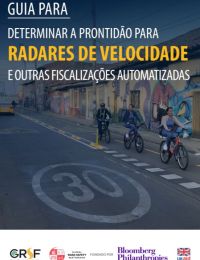
Este guia foi preparado para auxiliar uma jurisdição a determinar o nível de prontidão para mudar para a fiscalização automatizada (AE). Câmeras de velocidade que fiscalizam limites de velocidade são uma aplicação comum de AE e há muitos elementos legais e operacionais sistêmicos que devem estar em vigor antes que a AE possa ser eficaz. Por exemplo, uma imagem precisa de um veículo em alta velocidade, na ausência de sistemas robustos de licenciamento de motoristas e registro de veículos, tem pouco valor para a segurança nas estradas. É importante ressaltar que a fiscalização automatizada de velocidade deve ser considerada como parte de uma abordagem abrangente de gerenciamento de velocidade que inclua infraestrutura rodoviária e policiamento de beira de estrada também. A gestão da velocidade é um elemento fundamental do Sistema Seguro.
Objetivos deste documento:
Outros comportamentos ilegais, incluindo desobediência a um sinal vermelho, uso de telefone celular ou celular, uso incorreto de faixa e uso sem restrição também podem ser detectados usando uma abordagem de fiscalização automatizada. No entanto, este documento se aplica especificamente à fiscalização automatizada de velocidade, porque o gerenciamento de velocidade requer atenção significativa em todo o mundo e desempenha um papel crítico na redução de mortes e ferimentos no trânsito.
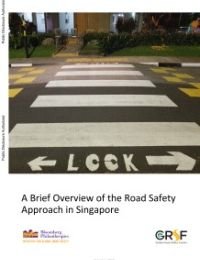
The report introduces how the Safe System Approach works, with a focus on road infrastructure and road safety engineering best practices from one of the best performing countries in Southeast Asia and the Pacific, Singapore.
Singapore roads are not only considered the safest in the region, they rank among the safest globally. Road safety management rules and regulations implemented in the country have resulted in significant strides in managing the effects of collision factors related to roadway design, human behavior, and vehicle attributes. As a result, road safety statistics have shown that fatalities on the Singapore road network have been steadily declining over the past decade. This is leading to a desire on the part of neighboring countries to follow Singapore's example and learn from its experience.
In order to mitigate collisions attributed to vehicle inadequacies or defects, one of the measures taken in Singapore was to enforce a strict vehicle import policy. Vehicle imports are permissible from countries that have adopted and comply with recognized high vehicle safety standards. Vehicle safety compliance is particularly focused on 52 items specified by the Land Transport Authority (LTA). In addition to strict vehicle import standards, Singapore enforces a strict vehicle quota system, which regulates the number of vehicles on the road network. Additionally, vehicles are required to undergo frequent inspections. Cars between 3 and 10 years old are required to have a biennial inspection, and cars older than 10 years are required to undergo annual inspections.
Furthermore, taxis are required to undergo inspections every six months. Road safety education and driver education are core tenants of Singapore's roads safety strategy. Road safety education is predominately undertaken by the Singapore Traffic Police, but nongovernmental organizations such as the National Security Coordination Secretariat contribute significantly to road safety education in Singapore.
Document also available in : Thai, Bahasa (Indonesian), Bahasa (Indonesian), Vietnamese
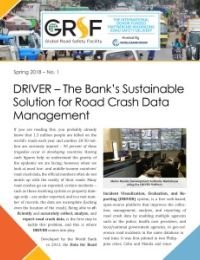
If you are reading this, you probably already know that 1.3 million people are killed on the world’s roads each year and another 20-50 million are seriously injured – 90 percent of these tragedies occur in developing countries. Having such figures help us understand the gravity of the epidemic we are facing; however, when we look at most low- and middle-income countries’ road crash data, the official numbers often do not match up with the reality of their roads.
Many road crashes go un-reported, certain incidents – such as those involving cyclists or property damage-only – are under-reported, and in a vast number of records, the data are incomplete (lacking even the location of the crash). Being able to efficiently and accurately collect, analyze, and report road crash data, is the first step to tackle this problem, and this is where DRIVER comes into play.
Developed by the World Bank in 2013, the Data for Road Incident Visualization, Evaluation, and Reporting (DRIVER) system, is a free web-based, open-source platform that improves the collection, management, analysis, and reporting of road crash data by enabling multiple agencies such as the police, health care providers, and local/national government agencies, to geo-reference road incidents in the same database in real time. It was first piloted in two Philippine cities, Cebu and Manila and since then, the GRSF has supported the improvement and deployment of DRIVER through workshops, pilot projects, implementation support and scaleup in countries such as Brazil, Bangladesh, India, Kazakhstan, Laos, Thailand, Vietnam, and Saudi Arabia.
